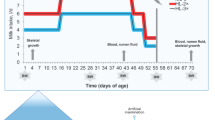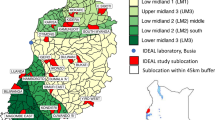Abstract
A SYNDROME of full-term still-births unassociated with any consistent evidence of infections or other specific causes is one which clinically has been associated with thyroid abnormality in cattle1–3. In a preliminary report on hypothyroidism in cattle2 it was pointed out that the evidence was insufficient to allow any conclusion on the significance of the apparent association of hypothyroidism, as reflected by blood iodine values and fœtal thyroid characteristics, with the clinical picture of aborted, stillborn and weakly calves. In an attempt to get more information on this apparent association, an examination was made of the thyroid glands of all complete aborted bovine fœtuses received at the Reading Veterinary Investigation Centre from the counties of Berkshire, Oxfordshire and Buckinghamshire. Thyroid glands judged to be oversized were weighed, and when overweight for the age of fœtus, were prepared for histological examination and iodine analysis. Of 1,629 fœtuses plus a few new-born calves which were examined, 160 from farms where there was a suspected thyroid problem had thyroids which were either overweight or, in a few cases, of normal weight. Of these, 95 were from calves born recently dead at the full term of pregnancy, and 8 from calves born alive but dying within a few days. This syndrome of full-term still-birth is that which clinically has been associated with thyroid abnormality in cattle. Of the remainder, 17 were aborted at 8–9 months' gestation, 25 at 7–8 months, 5 at 6–7 months, 2 at approximately 4 months, and in 8 cases the age was not recorded.
This is a preview of subscription content, access via your institution
Access options
Subscribe to this journal
Receive 51 print issues and online access
$199.00 per year
only $3.90 per issue
Buy this article
- Purchase on Springer Link
- Instant access to full article PDF
Prices may be subject to local taxes which are calculated during checkout
Similar content being viewed by others
References
Hignett, S. L., Mem. Soc. Endocrinol., No. 1, 21 (1953).
Allcroft, R., Scarnell, J., and Hignett, S. L., Vet. Rec., 66, 367 (1954).
Dawson, F. L. M., Vet. Rec., 70, 672, 842 (1958).
Hughes, D. E., Rodgers, K., and Wilson, D. C., Brit. Med. J., i, 280 (1959).
Murray, M. M., Ryle, J. A., Simpson, B. W., and Wilson, D. C., Med. Res. Coun. Mem. No. 18 (H.M.S.O., London, 1948).
Kilpatrick, R., Berry, W. T. C., and Horne, J. N., Proc. Nutr. Soc., 20, xxxvii (1961).
Russell, F. C., Imp. Bur. Animal Nutr. Tech. Comm. No. 15 (1944).
Kilpatrick, R., Broadhead, G. D., Edmonds, C. J., Munro, D. S., and Wilson, G. M., Excerpta Med. Intern. Cong., Ser. No. 26, Abst. 55 (1960).
Author information
Authors and Affiliations
Rights and permissions
About this article
Cite this article
LOOSMORE, R., ALLCROFT, R., SALT, F. et al. Thyroid Dysfunction in Aborted and New-born Calves. Nature 193, 595–596 (1962). https://doi.org/10.1038/193595b0
Issue Date:
DOI: https://doi.org/10.1038/193595b0
Comments
By submitting a comment you agree to abide by our Terms and Community Guidelines. If you find something abusive or that does not comply with our terms or guidelines please flag it as inappropriate.



